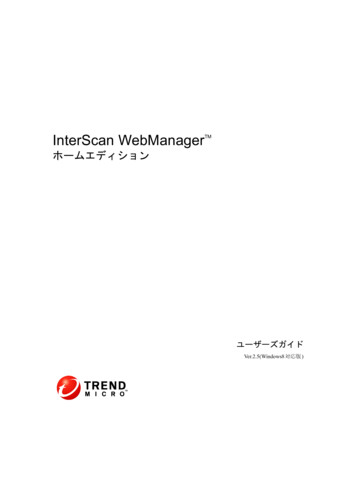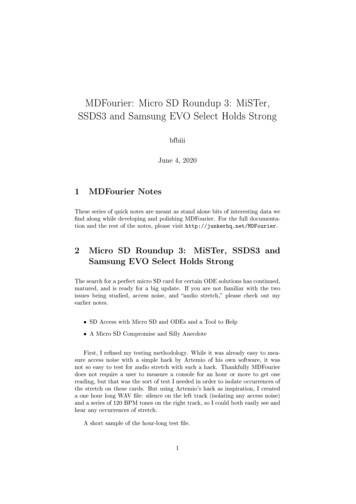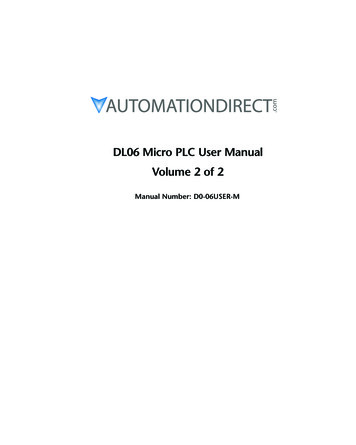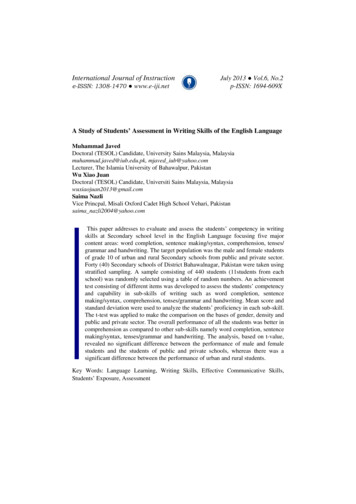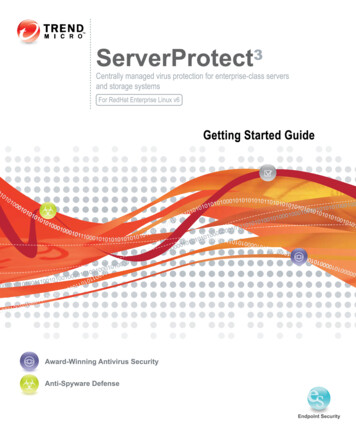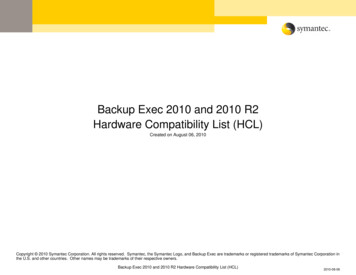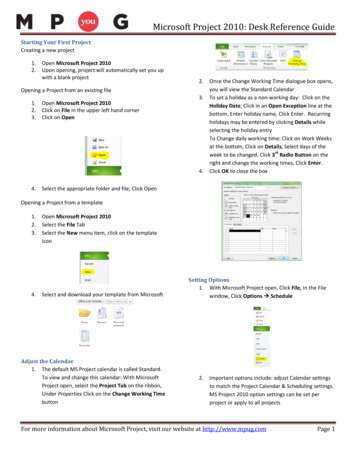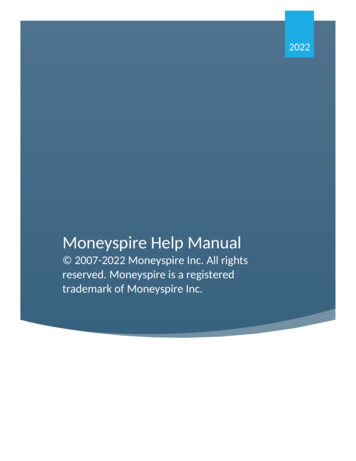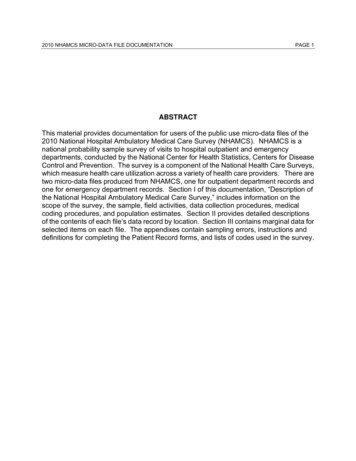
Transcription
2010 NHAMCS MICRO-DATA FILE DOCUMENTATIONPAGE 1ABSTRACTThis material provides documentation for users of the public use micro-data files of the2010 National Hospital Ambulatory Medical Care Survey (NHAMCS). NHAMCS is anational probability sample survey of visits to hospital outpatient and emergencydepartments, conducted by the National Center for Health Statistics, Centers for DiseaseControl and Prevention. The survey is a component of the National Health Care Surveys,which measure health care utilization across a variety of health care providers. There aretwo micro-data files produced from NHAMCS, one for outpatient department records andone for emergency department records. Section I of this documentation, “Description ofthe National Hospital Ambulatory Medical Care Survey,” includes information on thescope of the survey, the sample, field activities, data collection procedures, medicalcoding procedures, and population estimates. Section II provides detailed descriptionsof the contents of each file’s data record by location. Section III contains marginal data forselected items on each file. The appendixes contain sampling errors, instructions anddefinitions for completing the Patient Record forms, and lists of codes used in the survey.
PAGE 22010 NHAMCS MICRO-DATA FILE DOCUMENTATIONSUMMARY OF CHANGES FOR 2010The 2010 NHAMCS Emergency Department (ED) and Outpatient Department (OPD) public use micro-datafiles contain some important changes relative to the 2009 files. These mainly reflect changes to the surveyinstruments (the Patient Record form and the Hospital Induction Interview form) and are described in moredetail below.Emergency Departments1. New or Modified Itemsa. In item 1i, Expected Source of Payment, the category “Medicaid/SCHIP” was changed to“Medicald or CHIP/SCHIP”.b. In item 7, Diagnostic/Screening Services, the category “Pregnancy test” was changed to“Pregnancy/HCG test”.c. In item 12, Visit Disposition, the category “Left before medical screening exam” waschanged to “Left before triage.” The category “Left after medical screening exam” waschanged to “Left after triage”. One new category was added: “Return/Transfer to nursinghome.”d. In item 13a, Hospital Admission: Admitted to:, the category “Stepdown or telemetry unit”was changed to “Stepdown unit”.e. In item 13d, the question, “Date and time patient actually left the ED” was changed to“Date and time patient actually left the ED or observation unit”. However, this information is notprovided on the public use file.From the Hospital Induction Interview, two new items were added and one item was modified. Also,modifications were made to item 14, which concerns the adoption of Electronic MedicalRecords/Electronic Health Records (EMR/EHR). (EMR/EHR modifications are identical to thosemade in the 2010 National Ambulatory Medical Care Survey.)f. Items 11d and 11e: “Does your hospital have hospitalists on staff? and “Do thehospitalists on staff at your hospital admit patients from your ED?” were both added in2010.g. Item 14h, “Do ED physicians make decisions for patients in this observation or clinicaldecision unit?” (Answer categories were Yes, No, Not applicable) (OBSDEC on the publicuse file) was changed to, “What type of physicians make decisions for patients in thisobservation or clinical decision unit? (Answer categories are: ED Physicians, Hospitalists,Other Physicians, and Not Applicable) (OBSDECMD on the public use file)h. “Does your ED have a computerized system for patient demographic information?”was changed to “Does your ED have a computerized system for patient history &demographic information?”i. Does your ED have a computerized system for clinical notes, and, if yes, do they includemedical history and follow up notes?” was changed to “Does your ED have a computerized systemfor clinical notes, and, if yes, 1) do they include a list of medications that the patient is taking? and 2)do they include a comprehensive list of the patient’s allergies (including allergies to medication)?”j. “Does your ED have a computerized system for orders for tests?” was changed to “Doesyour ED have a computerized system for lab tests?
2010 NHAMCS MICRO-DATA FILE DOCUMENTATIONPAGE 3k. “Does your ED have a computerized system for viewing lab results?” – a sub-questionwas added: “If yes, are results incorporated in EMR/EHR?”l. “Does your ED have a computerized system for electronic reporting to immunizationregistries?” was added.m. “At your ED, if orders for prescriptions or lab tests are submitted electronically, whosubmits them?” was added. Note that this item, on the Hospital Induction Interview Form, does NOTimmediately follow the two questions about whether the ED has a computerized system for orders forprescriptions or for lab tests, but was added as a separate item following that entire section.Therefore, there was no skip pattern to link responses to this question with the previous twoquestions. Because of the independence of these items, inconsistencies were noted during dataprocessing between responses to the earlier items about whether the ED had a computerized systemfor orders for prescriptions or lab tests and responses to the later item about who submits suchorders. A decision was made in consultation with branch staff to present both versions of the “whosubmits them?” item – the first version is as reported and will sometimes conflict with responses tothe previous two questions. The second version has been recoded to take into account bothprevious questions. Researchers may make their own decisions about how to use these data.n. Does your hospital have plans to apply for Medicare or Medicaid incentive payments formeaningful use of Health IT? (Yes, Uncertain, No)o. What year does your hospital expect to apply for the meaningful use payments? (2011,2012, After 2012, Unknown)p. “Are there plans for installing a new EMR/EHR system or replacing the current systemwithin the next 3 years?” was changed to “At your ED, are there plans for installing a new EMR/EHRsystem within the next 18 months?”2. Deleted Itemsa. The year of visit item (VYEAR) is no longer included on the public use file. Although the NHAMCSreporting periods will often begin in the last week of December and end in the last week of thefollowing December, they are designed to yield statistics that are representative of the actualcalendar year. The survey variable YEAR continues to be on the file and all visit dates may beassumed to reflect the calendar year. If more specific information is required, it is necessary toaccess the data through the NCHS Research Data Center.b. Although still collected, the verbatim cause of injury item, VCAUSE, is not included on the 2010public use file. NCHS policy now requires that no new public use data files contain verbatim textresponses. In order to use VCAUSE data, it is necessary to access the data through the NCHSResearch Data Center. Please visit their website www.cdc.gov/rdc for additional information.c. From the Hospital Induction Interview form, the EMR question: “Does your practice have acomputerized system for viewing imaging results? – the sub-question, “If yes, are electronic imagesreturned?” was deleted.d. From the Hospital Induction Interview, the EMR question: “Does your practice have acomputerized system for public health reporting?” was deleted.
PAGE 42010 NHAMCS MICRO-DATA FILE DOCUMENTATIONOutpatient Departments1. New or Modified Itemsa. In Item 1. Patient Information, sub-item g) Expected source(s) of payment for this visit, checkbox 3,“Medicaid/SCHIP”, was changed to “Medicaid or CHIP/SCHIP”.b. In item 5, Provider’s Diagnosis for this Visit, sub-item b) “Regardless of the diagnoses written in 5a,does the patient now have”, under the checkbox for cancer, there are now 6 checkboxes to specifythe stage. Stage of cancer was last included on the Patient Record Form in 2008.c. In item 7, Diagnostic/Screening Services, the Pregnancy checkbox was changed toPregnancy/HCG Test.d. In item 9, Non-Medication Treatment, a checkbox was added for radiation therapy. This questionwas previously asked in 2008.From the Hospital Induction Interview, modifications were made to item 14, which is concerned withthe adoption of Electronic Medical Records/Electronic Health Records (EMR/EHR). Thesemodifications are identical to those listed in the section on Emergency Departments.e. “Does your OPD have a computerized system for patient demographic information?” waschanged to “Does your OPD have a computerized system for patient history & demographicinformation?”f. “Does your OPD have a computerized system for clinical notes, and, if yes, do theyinclude medical history and follow up notes?” was changed to “Does your OPD have a computerizedsystem for clinical notes, and, if yes, 1) do they include a list of medications that the patient is taking?and 2) do they include a comprehensive list of the patient’s allergies (including allergies tomedication)?”g. “Does your OPD have a computerized system for orders for tests?” was changed to“Does your OPD have a computerized system for lab tests?h. “Does your OPD have a computerized system for viewing lab results?” – a sub-questionwas added: “If yes, are results incorporated in EMR/EHR?”i. “Does your OPD have a computerized system for electronic reporting to immunizationregistries?” was added.j. “At your OPD, if orders for prescriptions or lab tests are submitted electronically, whosubmits them?” was added. Note that this item, on the Physician Induction Interview Form, doesNOT immediately follow the two questions about whether the OPD has a computerized system fororders for prescriptions or for lab tests, but was added as a separate item following that entiresection. Therefore, there was no skip pattern to link responses to this question with the previous twoquestions. Because of the independence of these items, inconsistencies were noted during dataprocessing between responses to the earlier items about whether the OPD had a computerizedsystem for orders for prescriptions or lab tests and responses to the later item about who submitssuch orders. A decision was made in consultation with branch staff to present both versions of the“who submits them?” item – the first version is as reported and will sometimes conflict withresponses to the previous two questions. The second version has been recoded to take intoaccount both previous questions. Researchers may make their own decisions about how to usethese data.k. Does your hospital have plans to apply for Medicare or Medicaid incentive payments formeaningful use of Health IT? (Yes, Uncertain, No)
2010 NHAMCS MICRO-DATA FILE DOCUMENTATIONPAGE 5l. What year does your hospital expect to apply for the meaningful use payments? (2011,2012, After 2012, Unknown)m. “Are there plans for installing a new EMR/EHR system or replacing the current systemwithin the next 3 years?” was changed to “At your hospital, are there plans for installing a newEMR/EHR system within the next 18 months?”2. Deleted Itemsa. The year of visit item (VYEAR) is no longer included on the public use file. Although the NHAMCSreporting periods will often begin in the last week of December and end in the last week of thefollowing December, they are designed to yield statistics that are representative of the actualcalendar year. The survey variable YEAR continues to be on the file and all visit dates may beassumed to reflect the calendar year. If more specific information is required, it is necessary toaccess the data through the NCHS Research Data Center.b. From the Hospital Induction Interview form, the EMR question: “Does your hospital havea computerized system for viewing imaging results? – the sub-question, “If yes, are electronicimages returned?” was deleted.c. From the Hospital Induction Interview form, the EMR question: “Doesyour hospital have a computerized system for public health reporting?” was deleted.Injury-Related DataIn item 5 of the NHAMCS Emergency Department Patient Record Form (PRF) and item 2 of the NHAMCSOPD PRF, data are collected on whether the sampled visit is related to an injury, poisoning, or adverseeffect. In past years, responses to each item were combined with data on the patient’s reason for the visit(item 4 [ED], item 3 [OPD]) in 2010), physician’s diagnosis (item 6 [ED], item 5 [OPD] in 2010), and causeof injury (item 5 [ED]) to derive a yes/no indicator of whether the visit was injury related. However, thedefinition of what constituted an injury visit, chosen by senior branch staff many years ago, was fairly broad.For 2010, in collaboration with injury experts at NCHS’s Office of Analysis and Epidemiology (OAE), an effortwas made to provide alternative injury variables that are more conservative and better reflect the OAEdefinition of an injury visit. The OAE definition is more closely aligned with the global injury community, thusbringing NHAMCS data closer to a more widely held definition, while still retaining the original injury items forthose who may prefer the broader definition. Two new injury indicators have been added to each file: INJR1and INJR2. In addition, the editing of OPD PRF item 2 has been refined to add two new recoded versionsof the original INJDET data -- INJDETR1 and INJDETR2. For the ED file, two new variables indicatingwhether the visit was the result of an adverse effect or complication (ADVCOMP1 and ADVCOMP2) havebeen added based on a recoding of the reason for visit, cause, and diagnosis.What are the differences between these items?INJURY – This is the historical NHAMCS yes/no indicator. For OPD data, it uses a broad definition basedon first-, second-, and third-listed reason for visit and diagnosis codes to determine whether a visit is injuryrelated. For ED data, cause of injury is also taken into account.In addition to injury, poisoning, and adverse effects and complications codes from the NCHS Reason forVisit Classification (RVC) and the International Classification of Diseases, Ninth Revision, ClinicalModification (ICD-9-CM), a selection of other reason and diagnosis codes relating to various conditions (forexample, carpal tunnel syndrome, allergic reactions, alcohol and drug abuse, birth trauma, and others) wasused to indicate an injury-related visit.INJR1 – For OPD, this definition includes only first-listed reason for visit and diagnosis codes related toinjury and poisoning. It does NOT include adverse effects and complications codes. No additional codes
PAGE 62010 NHAMCS MICRO-DATA FILE DOCUMENTATIONfrom the RVC and ICD-9-CM are used. For ED, cause of injury is also taken into consideration, such that,if the first-listed reason for visit or first-listed diagnosis is not injury related, the presence of a first-listed causeof injury will also cause the visit to be considered injury related (excluding adverse effects and complicationscodes).INJR2 – For OPD, this injury definition includes first-, second-, and third-listed reason for visit and diagnosescodes related to injury and poisoning. Adverse effects and complications codes are not included, and noadditional codes from the RVC and ICD-9-CM are used. For ED, the definition includes any-listed first-,second-, and third-listed reason for visit and diagnosis, but also considers the presence of a cause of injury(excluding adverse effects and complications codes; however, if adverse effects or complications codes arepresent in combination with other valid definitional codes, the visit will be considered injury related).INJDET – This is the historical NHAMCS OPD variable reflecting item 2 on the PRF. It uses a broaddefinition of injury based on first-, second-, and third-listed reason for visit and diagnosis codes inconjunction with item 2 entries to determine whether a visit is related to injury, poisoning, or adverse effectof medical/surgical care or adverse effect of medicinal drug.INJDETR1 – This definition uses item 2 entries in conjunction with 1) the injury definition used in INJR1 and2) an additional review of first-listed reason for visit and diagnosis codes to determine whether the visit isrelated to adverse effects of medical or surgical care or adverse effects of medicinal drugs.INJDETR2 – This definition uses item 2 entries in conjunction with 1) the injury definition used in INJR2 and2) an additional review of first-, second-, and third-listed reason for visit and diagnosis codes to determinewhether the visit is related to adverse effects of medical or surgical care or adverse effects of medicinaldrugs.ADVCOMP1 – This definition uses first-listed reason for visit, cause of injury, and diagnosis to determinewhether the visit is related to adverse effects of medical or surgical care or adverse effects of medicinaldrugs.ADVCOMP2 – This definition uses any-listed reason for visit, cause of injury, and diagnosis to determinewhether the visit is related to adverse effects of medical or surgical care or adverse effects of medicinaldrugs.It is hoped that these additional injury items will provide a better picture of injury visits in NHAMCS. For moreinformation, please contact the Ambulatory and Hospital Care Statistics Branch at 301-458-4600.
2010 NHAMCS MICRO-DATA FILE DOCUMENTATIONPAGE 7Table of ContentsPageAbstract .1Summary of Changes for 2010 .2I. Description of the National Hospital Ambulatory Medical Care Survey.9A. Introduction .9B. Sample design .10C. Data collection procedures .12D. Field quality control .17E. Confidentiality .17F. Data processing .18G. Medical coding .19H. Estimation procedures .24I. Patient visit weight .25J. Hospital code and patient code .26K. Clinic type code .26L. Use of the ED and OPD weights .26M. Population figures .27References .34II Record FormatsA. Format of Emergency Department Micro-Data File .35B. Format of Outpatient Department Micro-Data File .78III Marginal DataA. Emergency department patient visits.119B. Emergency department drug mentions.121C. Emergency departments .122D. Outpatient department patient visits .123E. Outpatient department drug mentions .125F. Outpatient departments .127AppendixesAppendix IA. Relative standard errors.128B. Instructions for completing Patient Record forms . 131C. Definitions of certain terms used in the survey .156Appendix IIA. Reason for Visit Classification - summary of codes .163B. Reason for Visit Classification - tabular listing .165Appendix IIIA. Generic codes and names in numeric order .201B. Drug entry codes and names in numeric order .229C. Multum End-User License Agreement .269D. Multum Classification of Therapeutic Classes (Drug Categories).273
PAGE 82010 NHAMCS MICRO-DATA FILE DOCUMENTATIONTable of Contents (cont.)PageList of Tables and FiguresTable I. U.S. population estimates used in computing annual visit rates for theNational Ambulatory Medical Care Survey and the National Hospital AmbulatoryMedical Care Survey, by selected characteristics: July 1, 2010 .28Table II. U.S. population estimates used in computing annual visit rates for theNational Ambulatory Medical Care Survey and the National Hospital AmbulatoryMedical Care Survey, by ethnicity, age, race, and sex: July 1, 2010 .30Table III. Coefficients appropriate for determining approximate relative standard errors of estimatesby type of estimate and setting: National Hospital Ambulatory Medical Care Survey, 2010 130Figure 1. Outpatient Department Patient Record Form.14Figure 2. Emergency Department Patient Record form .15
2010 NHAMCS MICRO-DATA FILE DOCUMENTATIONPAGE 9I. DESCRIPTION OF THE NATIONAL HOSPITAL AMBULATORY MEDICAL CARE SURVEYA. INTRODUCTIONThe National Hospital Ambulatory Medical Care Survey (NHAMCS) was initiated to learn more about theambulatory care rendered in hospital emergency and outpatient departments (EDs and OPDs) in the UnitedStates. In 2009, hospital-based ambulatory surgery locations were included in the survey and, in 2010,freestanding ambulatory surgery centers were added. This documentation pertains only to the ED and OPDsurvey components. Ambulatory medical care is the predominant method of providing health care servicesin the United States (1). Since 1973, data on ambulatory patient visits to physicians' offices have beencollected through the National Ambulatory Medical Care Survey (NAMCS). However, visits to hospitalemergency and outpatient departments, which represent a significant portion of total ambulatory medicalcare, are not included in NAMCS (2). Furthermore, hospital ambulatory patients are known to differ fromoffice patients in their demographic and medical characteristics (3). NHAMCS was designed to fill this datagap. Together, NAMCS and NHAMCS provide a comprehensive look at ambulatory medical care.NHAMCS is endorsed by the Emergency Nurses Association, the Society for Emergency AcademicMedicine, the American College of Emergency Physicians, and the American College of OsteopathicEmergency Physicians. A complete description of NHAMCS is contained in the publication entitled, "Planand Operation of the National Hospital Ambulatory Medical Care Survey" (4).These micro-data files comprise the emergency and outpatient department data collected by NHAMCS in2010. NHAMCS is conducted by the Ambulatory and Hospital Care Statistics Branch of the National Centerfor Health Statistics (NCHS), Centers for Disease Control and Prevention (CDC). NHAMCS provides datafrom samples of patient records selected from the EDs and OPDs of a national sample of hospitals. Asmentioned earlier, hospital-based ambulatory surgery centers were added in 2009, and freestandingambulatory surgery centers were added in 2010. Data from the Ambulatory Surgery Component ofNHAMCS will be released separately. The national estimates produced from these studies describe theutilization of hospital ambulatory medical care services in the United States. In 2010, there were 34,936Patient Record forms (PRFs) provided by EDs and 34,718 PRFs provided by OPDs that participated in thesurvey. Both data files, ED and OPD, are included in this product.Please note the following important points concerning analysis of NHAMCS data on this micro-data file: PATIENT VISIT WEIGHTMicro-data file users should be fully aware of the importance of the "patient visit weight" and howit must be used. Information about the patient visit weight is presented on page 27. If moreinformation is needed, the staff of the Ambulatory and Hospital Care Statistics Branch can beconsulted by calling (301) 458-4600 during regular working hours. RELIABILITY OF ESTIMATESUsers should also be aware of the reliability or unreliability of certain estimates, particularly thesmaller estimates. The National Center for Health Statistics considers an estimate to be reliableif it has a relative standard error of 30 percent or less (i.e., the standard error is no more than 30percent of the estimate). Therefore, it is important to know the value of the lowest possibleestimate in this survey that is considered reliable, so as not to present data in a journal article orpaper that may be unreliable. Most data file users can obtain an adequate working knowledge ofrelative standard errors from the information presented in Appendix I. It should be noted thatestimates based on fewer than 30 records are also considered unreliable, regardless of themagnitude of the relative standard error. If you would like more information, do not hesitate toconsult the staff of the Ambulatory and Hospital Care Statistics Branch.
PAGE 102010 NHAMCS MICRO-DATA FILE DOCUMENTATIONB. SAMPLE DESIGNThe 2010 NHAMCS was a national probability sample of visits to the emergency and outpatient departmentsof noninstitutional general and short-stay hospitals, excluding Federal, military, and Veterans Administrationhospitals, located in the 50 states and the District of Columbia. NHAMCS was designed to provideestimates based on the following priority of survey objectives: United States; region; emergency andoutpatient departments; and type of ownership. NHAMCS used a four-stage probability design with samplesof primary sampling units (PSUs), hospitals within PSUs, clinics/emergency service areas withinoutpatient/emergency departments, and patient visits within clinics/emergency service areas. Each stageof sampling is described below.1. Primary Sampling Units (PSUs)A PSU consists of a county, a group of counties, county equivalents (such as parishes and independentcities), towns, townships, minor civil divisions (for some PSUs in New England), or a metropolitan statisticalarea (MSA). MSAs were defined by the U.S. Office of Management and Budget on the basis of the 1980Census. The first-stage sample consisted of 112 PSUs that comprised a probability subsample of the PSUsused in the 1985-94 National Health Interview Survey (NHIS). The NHAMCS PSU sample included withcertainty the 26 NHIS PSUs with the largest populations. In addition, the NHAMCS sample includedone-half of the next 26 largest PSUs, and one PSU from each of the 73 PSU strata formed from theremaining PSUs for the NHIS sample.The NHIS PSU sample was selected from approximately 1,900 geographically defined PSUs that coveredthe 50 States and the District of Columbia. The 1,900 PSUs were stratified by socioeconomic anddemographic variables and then selected with a probability proportional to their size. Stratification was donewithin four geographical regions by MSA or non-MSA status. A detailed description of the 1985-94 NHISPSU sample design is available (5).2. HospitalsThe sampling frame for the 2010 NHAMCS was constructed from SDI’s data product, “Hospital MarketProfiling Solution.” (SDI has since been acquired by IMS.)The original sample frame was compiled as follows. Hospitals with an average length of stay for all patientsof less than 30 days (short-stay) or hospitals whose specialty was general (medical or surgical) or children'sgeneral were eligible for NHAMCS. Excluded were Federal hospitals, hospital units of institutions, andhospitals with less than six beds staffed for patient use. In 1991, the SMG Hospital Database contained6,249 hospitals that met these eligibility criteria. Of the eligible hospitals, 5,582 (89 percent) had EDs and5,654 (90 percent) had OPDs. Hospitals were defined to have an ED if the hospital file indicated thepresence of such a unit or if the file indicated a non-zero number of visits to such a unit. A similar rule wasused to de
The 2010 NHAMCS Emergency Department (ED) and Outpat ient Department (OPD) public use micro-data files contain some important changes relative to the 2009 files. These mainly reflect changes to the survey instruments (the Patient Record form and the Hospital Inductio
